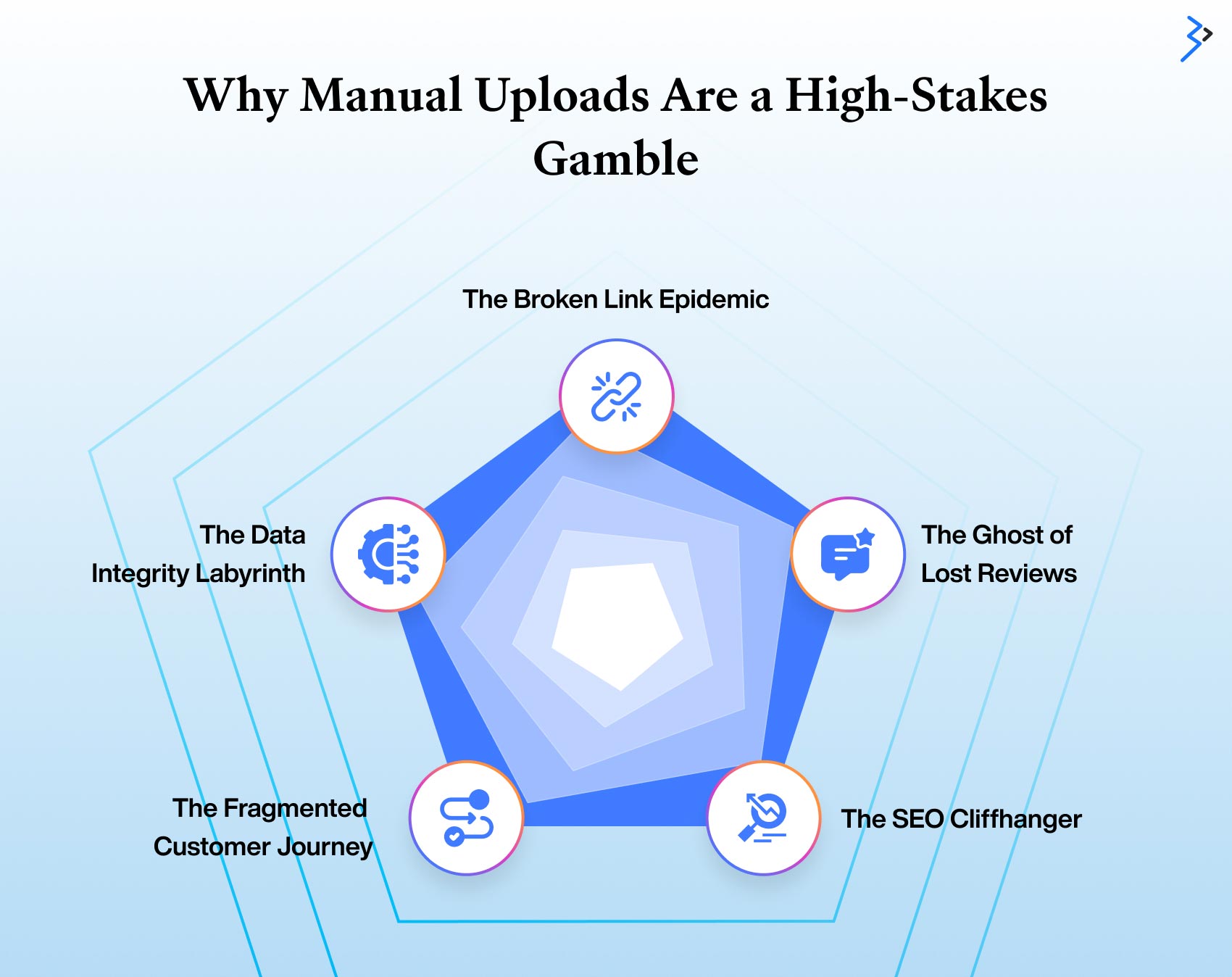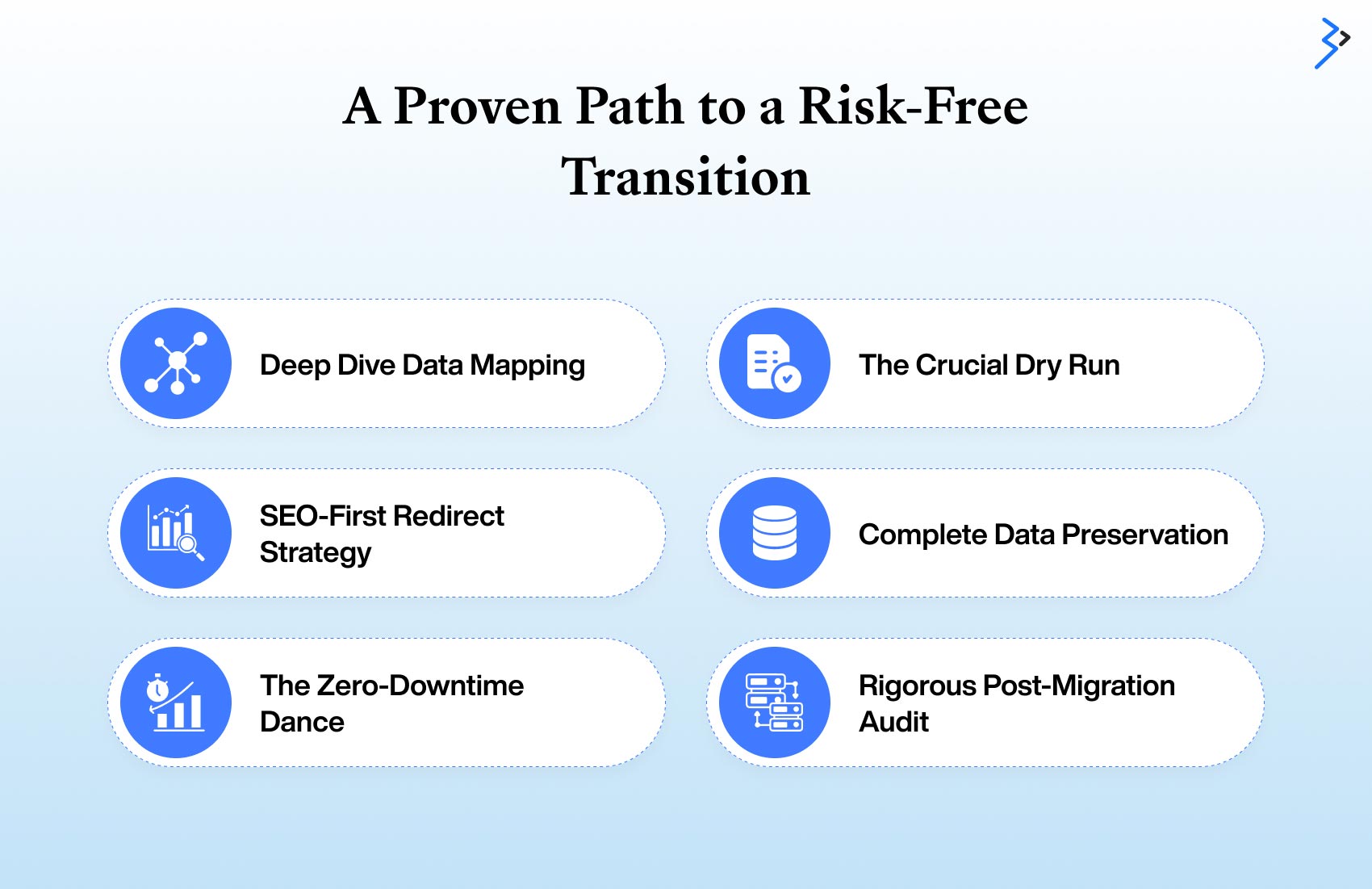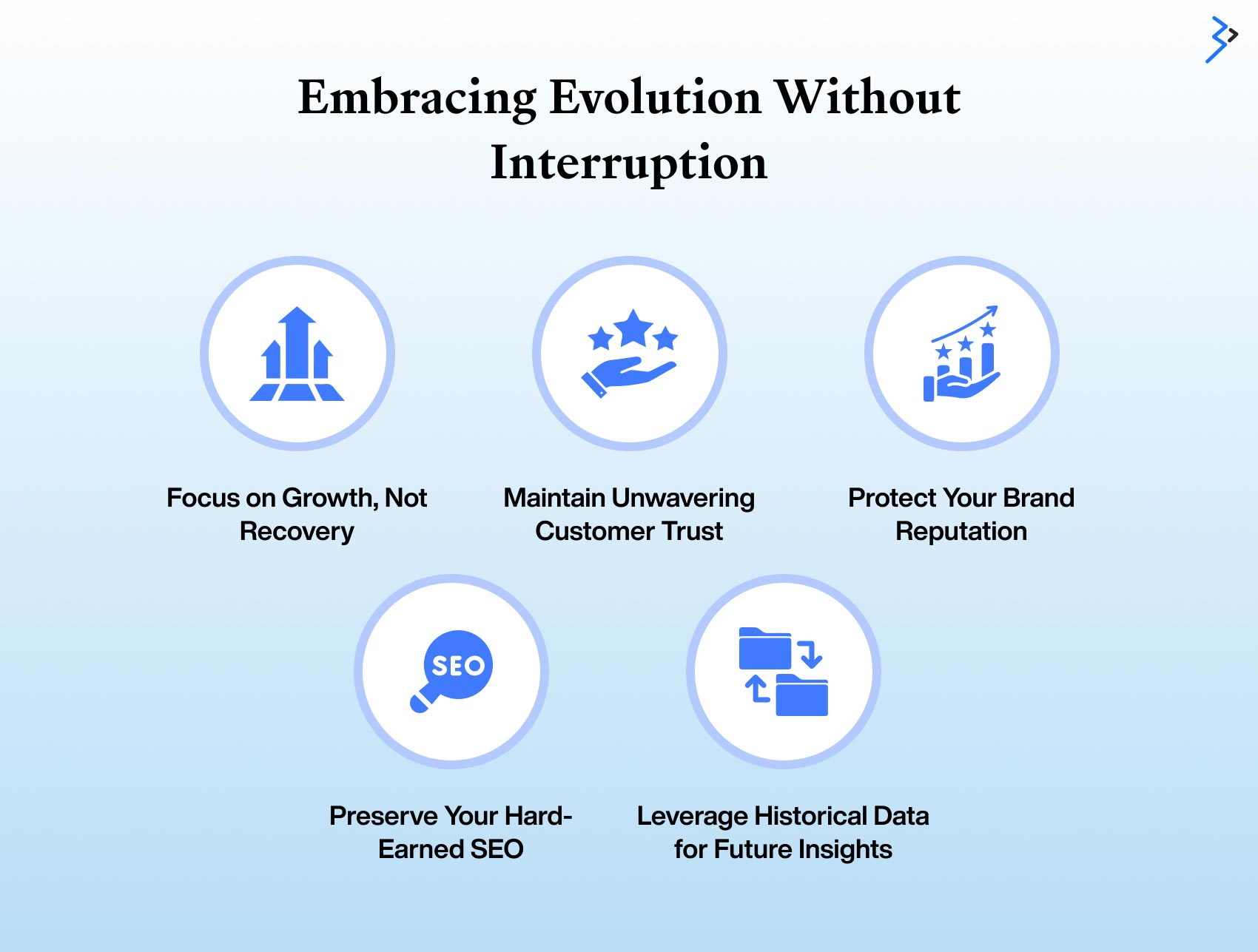Table of contents
Why Manual Uploads Are a High-Stakes Gamble
A Proven Path to a Risk-Free Transition
Embracing Evolution Without Interruption
Conclusion
Frequently Asked Questions
The digital storefront, much like a physical one, occasionally needs a facelift, a relocation to a more bustling street, or an upgrade to better infrastructure. This often translates to the daunting prospect of platform migration for eCommerce businesses. The promise of enhanced features, better scalability, and a more streamlined ecosystem can be incredibly enticing. Yet, lurking beneath this promise is a primal fear: disruption. The chilling thought of a website going dark, even for a moment, losing valuable data, or witnessing hard-earned SEO rankings plummet, can paralyze even the most decisive entrepreneur.
But what if this fear is essentially a ghost of eCommerce's past? What if the transition to a new platform, be it for enhanced performance, better features, or strategic realignment, could be achieved with the precision of a surgeon, the reliability of a Swiss timepiece, and—crucially—with zero downtime and a risk-free transfer of your digital assets?
This isn't a utopian fantasy; it's the reality that a well-architected migration process can deliver. We're not just talking about moving files from one server to another. We're talking about a carefully orchestrated symphony of data mapping, meticulous dry runs, the strategic deployment of SEO-friendly redirects, and the unwavering preservation of your online business's lifeblood: customer and order history.
A study by Gremlin reported that Amazon loses more than $220,000 per minute of downtime. In a digital landscape where even a few minutes of downtime can translate to significant revenue loss and where losing years of customer data is akin to erasing your business's memory, the concept of a risk-free, zero-downtime transition isn't just a luxury – it's a necessity for sustained growth and customer trust.

Why Manual Uploads Are a High-Stakes Gamble
The allure of manual uploads can be strong, especially for smaller businesses. It seems straightforward: export your data, perhaps massage it in a spreadsheet, and then import it into the new platform. However, this seemingly simple approach is often fraught with hidden dangers, like navigating a minefield blindfolded.
The Broken Link Epidemic
Manual handling of URLs, especially for product pages and blog posts, is a breeding ground for broken links. Imagine a customer clicking on a product they've bookmarked or a link from a social media post, only to be met with a dreaded "404 Not Found" error. This not only frustrates customers but also signals to search engines that your website is poorly maintained, leading to a drop in Google rankings, where even a small percentage of broken links can negatively impact your SEO health.
The Ghost of Lost Reviews
Product reviews are digital gold. They build trust, influence purchasing decisions, and contribute to SEO. According to BrightLocal, 88% of consumers trust online reviews as much as personal recommendations. Manual migration often overlooks these crucial elements, leaving your new store devoid of the social proof you've worked hard to build.
The SEO Cliffhanger
As mentioned earlier, haphazard URL changes without proper redirects are an SEO disaster waiting to happen. Search engines have indexed your old URLs, and if those pathways suddenly lead nowhere, you'll lose the organic traffic you've painstakingly cultivated. Forbes reports that the first five organic results account for 67.6% of all the clicks, highlighting the catastrophic impact of a rankings drop.
The Fragmented Customer Journey
Imagine your loyal customers logging into your new store only to find their past order history vanished, their saved addresses missing, or their loyalty points gone. This creates a disjointed and frustrating experience, potentially leading them to question your professionalism and seek alternatives. Remember, retaining existing customers is significantly cheaper than acquiring new ones.
The Data Integrity Labyrinth
Manual manipulation of data in spreadsheets is prone to human error. Missing fields, incorrect formatting, and accidental deletions can lead to inconsistencies and inaccuracies in your new store, impacting everything from product pricing to inventory management.

A Proven Path to a Risk-Free Transition
At Brainvire, our approach to platform migration isn't about crossing our fingers and hoping for the best. It's a meticulously crafted, tested, and proven flow designed to eliminate risk and ensure a seamless transition with zero downtime. Here's how we achieve this:
Deep Dive Data Mapping
We don't just unthinkingly move data; we understand its intricate structure. Our experts meticulously map the data fields from your existing platform to their precise counterparts in the new system. We analyze your product catalogs down to the most granular attributes (size, color, material, SKUs, variants, images, associated files), scrutinize your customer databases (including purchase history, preferences, addresses, loyalty points, communication logs), and map your order management system (encompassing order dates, items, shipping details, payment information, return history). This ensures that every piece of information – from complex product attributes to nuanced customer preferences – finds its correct home.
The Crucial Dry Run
Before the actual migration, we conduct comprehensive dry runs. This involves migrating a complete copy of your store's data to a staging environment – a mirror image of your future setup. We migrate 100% of your data, mirroring the exact conditions of the final cutover. This allows us to identify and resolve any potential roadblocks proactively – be it data format incompatibilities, intricate data transformations required, or unforeseen functional conflicts. It acts as our early warning system, allowing us to fine-tune the migration scripts, optimize the transfer process, and guarantee flawless execution when it truly matters.
[ Read More: Shopify Data Migration Guide ]
SEO-First Redirect Strategy
We understand the vital importance of preserving your SEO equity. Our process includes a strategic plan for implementing 301 redirects for every relevant URL on your old platform to its corresponding page on the new one. This ensures that search engines seamlessly transfer your link authority and that your hard-earned rankings remain intact. We leverage industry best practices to ensure a smooth transition for search engine crawlers, minimizing any potential dips in visibility. We adhere to Google's best practices for website migrations. We utilize sophisticated redirect management tools and conduct thorough post-migration SEO audits to verify the correct implementation and minimize potential dips in search engine visibility.
Complete Data Preservation
Your customer and order history are invaluable assets. Our migration process ensures the complete and accurate transfer of this data. Customers will find their past purchases, saved information, and loyalty status intact, fostering a sense of continuity and trust. This also allows you to maintain accurate historical sales data for analysis and reporting.
The Zero-Downtime Dance
This is the cornerstone of our risk-free approach. We employ sophisticated techniques, often involving parallel environments and carefully timed DNS (Domain Name System) switches, to ensure that your website remains live and accessible to your customers throughout the entire migration process. It's a seamless handover that your customers won't even notice.
Rigorous Post-Migration Audit
Once the migration is complete, our team will thoroughly audit your new store. We meticulously check data integrity, test all functionalities, and ensure everything works as expected. This multi-layered verification process minimizes the chances of any post-launch surprises.

Embracing Evolution Without Interruption
When executed with precision and focused on risk mitigation, platform migration isn't just a technical upgrade; it's a strategic evolution. It's about embracing new possibilities without sacrificing the foundations you've built. The ability to transition seamlessly, without the fear of downtime or data loss, empowers businesses to be more agile, more responsive to market changes, and, ultimately, more successful.
This approach reflects a fundamental shift in how we view eCommerce infrastructure. Significant disruption is no longer acceptable as an inevitable part of progress. The technology and expertise exist to navigate these transitions with grace and efficiency.
By prioritizing a risk-free, zero-downtime migration, businesses can:
- Focus on Growth, Not Recovery: Instead of spending valuable time and resources fixing post-migration issues, you can immediately leverage the new platform's features to drive growth and innovation.
- Maintain Unwavering Customer Trust: A seamless transition reinforces your commitment to providing a consistent and reliable customer experience.
- Protect Your Brand Reputation: Avoiding website downtime and data loss prevents negative customer perceptions and maintains a professional image.
- Preserve Your Hard-Earned SEO: Ensuring a smooth transfer of SEO equity safeguards your organic traffic and long-term visibility.
- Leverage Historical Data for Future Insights: Maintaining complete customer and order history allows for richer analytics and more informed business decisions.
Conclusion
In conclusion, the era of disruptive platform migrations is over. With a tested and proven process that prioritizes meticulous planning, data integrity, SEO preservation, and, most importantly, zero downtime, businesses can embrace the evolution of their eCommerce platforms with confidence and without regret.
It's about moving forward without leaving anything valuable behind, ensuring that your online store's silent revolution is a resounding success, noticed only by its enhanced performance and happier customers.
The future of eCommerce migration is seamless, and those who embrace this approach will thrive in the ever-evolving digital landscape.
Frequently Asked Questions
How critical is zero downtime during an eCommerce platform migration?
Zero downtime is paramount because any outage directly translates to lost revenue. Studies show that even a minute of downtime can cost significant sums, especially for larger retailers. Beyond immediate sales, downtime erodes customer trust, damages brand reputation, and can negatively impact SEO rankings as search engines penalize unavailable sites, leading to long-term traffic loss.
What are the SEO risks of manual eCommerce platform migration?
Manual URL handling is a significant SEO hazard. It often results in broken links that frustrate users and signal a poorly maintained site to search engines, leading to ranking drops. Without proper 301 redirects, valuable organic traffic, which accounts for many website visits, can plummet. Furthermore, lost product reviews eliminate valuable, keyword-rich content that influences both SEO and conversions.
How does a risk-free migration process ensure data integrity?
A proven process involves deep data mapping to precisely align fields, crucial dry runs in a staging environment to identify and fix errors, and rigorous post-migration audits to verify accuracy. This multi-step approach minimizes data loss and inconsistencies.
What's the benefit of preserving customer and order history during migration?
Preserving this "vault of history" ensures a seamless customer experience, maintaining loyalty and trust. Customers find past purchases and saved data intact. Historical data also allows businesses to leverage it for analysis and personalized marketing, boosting retention.
What key techniques enable a zero-downtime eCommerce migration?
Sophisticated techniques like parallel environments, where the new store is built live alongside the old, and precisely timed DNS switches ensure continuous website availability. This seamless handover is often imperceptible to customers, preventing any disruption to their shopping experience.
Related Articles
Digital Transformation
Your Guide to End-to-End eCommerce Migration with SEO Integrity
Digital Transformation
Shopify Data Migration Made Easy: Your Ultimate Guide

